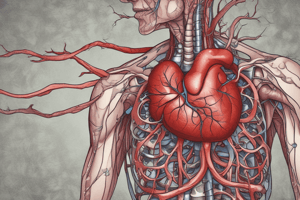Podcast
Questions and Answers
What does the circulatory system consist of?
What does the circulatory system consist of?
- The heart and blood vessels (correct)
- Only blood vessels
- Only the heart
- Heart, lungs, and blood vessels
What are the anatomical classifications of blood vessels?
What are the anatomical classifications of blood vessels?
Arteries, Capillaries, and Veins
What do arteries do?
What do arteries do?
They carry blood away from the heart.
What are capillaries?
What are capillaries?
What do veins do?
What do veins do?
Arteries carry blood away from the heart, and __ return blood to the heart.
Arteries carry blood away from the heart, and __ return blood to the heart.
What are the three layers of blood vessels, except for capillaries?
What are the three layers of blood vessels, except for capillaries?
What is the Tunica Intima?
What is the Tunica Intima?
What is the Tunica Media?
What is the Tunica Media?
What is the Tunica Adventitia?
What is the Tunica Adventitia?
What are varicose veins?
What are varicose veins?
What is the significance of arterioles?
What is the significance of arterioles?
What do capillaries facilitate?
What do capillaries facilitate?
What percentage of blood volume do venules and veins temporarily store?
What percentage of blood volume do venules and veins temporarily store?
What are the major arteries of the systemic circulation?
What are the major arteries of the systemic circulation?
Where does the Aorta originate?
Where does the Aorta originate?
What does the Aorta split into?
What does the Aorta split into?
What does the aortic arch supply?
What does the aortic arch supply?
What do the left and right subclavian arteries supply?
What do the left and right subclavian arteries supply?
Flashcards are hidden until you start studying
Study Notes
Circulatory System Overview
- Composed of the heart and blood vessels, serving to transport blood throughout the body.
Blood Vessel Classification
- Anatomically divided into three main types: Arteries, Capillaries, and Veins.
Arteries
- Carry blood away from the heart; includes increasingly smaller branches leading to arterioles.
- Arterioles transport oxygenated blood and regulate blood flow.
Capillaries
- Smallest and most abundant blood vessels connecting arterioles to venules.
- Facilitate the exchange of oxygen, nutrients, and waste at the cellular level.
Veins
- Return blood back to the heart, collecting it from capillaries into venules, which merge into larger veins.
- The smallest veins, venules, converge to form larger veins, eventually emptying into the Right Atrium; primarily transport unoxygenated blood.
Structure of Blood Vessels
- Except for capillaries, vessels consist of three layers:
- Tunica Intima: Smooth inner layer for efficient blood flow.
- Tunica Media: Thickest layer, made of elastic tissue and smooth muscle, varying in composition to suit vessel function.
- Tunica Adventitia: Outer layer of tough connective tissue for support and protection.
Varicose Veins
- Twisted, distended veins due to poor blood drainage, often resulting from defective valves.
Resistance Vessels
- Arterioles can regulate their radius through contraction and relaxation, affecting blood flow resistance.
Capacitance Vessels
- Venules and veins store approximately 70% of blood volume and regulate flow back to the heart when needed.
Major Arteries in Systemic Circulation
- Include the Aorta and its branches, with all arteries originating directly or indirectly from it.
Aorta
- Originates in the left ventricle; extends through the thorax and abdomen, splitting into common iliac arteries in the pelvic cavity.
Aortic Segmentation
- Divided into segments based on path (Ascending, Arch, Descending) and body cavity location (Thoracic, Abdominal).
Ascending Aorta
- First branches nourish the myocardium through the left and right coronary arteries.
Aortic Arch
- Connects the ascending and descending aorta and gives rise to major arteries supplying the head, neck, shoulders, and arms.
Major Branches from the Aortic Arch
- Brachiocephalic Artery: Supplies the right side of the head.
- Left Common Carotid Artery: Supplies the left side of the head and neck.
- Left and Right Subclavian Arteries: Supply blood to shoulders and upper extremities; arise differently from the aortic arch.
Studying That Suits You
Use AI to generate personalized quizzes and flashcards to suit your learning preferences.




